If you have seen the EFL League Two table lately, you’ll know how close the race for the playoffs and automatic promotion is (apart from Leyton Orient who are 13 points clear atop of the league). In a league where anybody can beat anybody on any given day, there really is little room for teams to slip up, yet we still see it.
With the season climax drawing ever closer, now is the time when promotion hopefuls are really praying they can string a sequence of wins together to boost their chances, which is exactly what sixth-placed Stockport County have done. In their last fixture, Dave Challinor’s men beat second-place Stevenage in a 2-0 win to chalk up their fourth consecutive victory. Meanwhile, this result means that Stevenage are now without a win in four games.
In this tactical analysis, we will take a look at how Stockport’s tactics allowed them to collect three points and a clean sheet, taking advantage of an out-of-form side, with an analysis of their build-up in wide areas. This also features a brief analysis of Myles Hippolyte’s contributions to the game – the travelled winger came through the ranks at now-Premier League side Brentford but is enjoying life at Stockport. Finally, there will be an analysis of Stevenage’s struggle in attack as they failed to land a glove on the hosts.
Lineups
Hosts Stockport (who are marked red on the lineup visual, but actually wore blue in the game, by the way!) lined up in their regular 3-5-2, with an identical lineup to their previous fixture – a 2-1 win over Crawley Town. Kyle Wootton scored both goals in that tie and partnered with Isaac Olaofe in the attack. Will Collar, who netted the opening goal against Stevenage in the first half, operated on the left side of a midfield three, with Ryan Croasdale and Callum Camps joining him in the engine room.
County used their substitutes to good effect this time around, introducing Ryan Johnson and Ryan Rydel, with the latter scoring the second deep into injury time in the second half to kill any hope of a Stevenage equaliser.
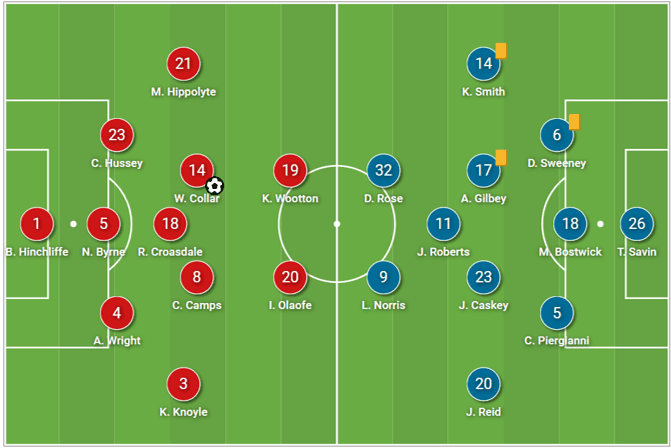
Stevenage boss and former EFL Championship manager Steve Evans, who last month extended his contract until 2025, lined his side up in a 3-5-2, which often operated as a 5-3-2 out of possession, with a number of changes to the starting eleven from their 2-2 draw last time out against Newport County. One of those changes came between the sticks, with Accrington Stanley loanee Toby Savin coming straight into the side, making his debut to replace injured first-choice keeper Jokull Andresson. Veteran Michael Bostwick returned to central defence after featuring in midfield previously – the midfield in this tie now consisted of Alex Gilby, Jake Caskey, and Jordan Roberts. Jamie Reid also came into the side, replacing Max Clark at left wing-back. In attack, Danny Rose joined Luke Norris, replacing recent signing Josh March.
How Stockport Utilised higher possession
Stockport registered a sizable 59% possession against Stevenage, but they aren’t always so dominant in that respect, with their game usually a lot closer when it comes to possession. While Stevenage are no strangers to surrendering the higher portion of ball time, it may have come as a surprise to County to have as much time as they did, as they seemed to be struggling for fresh ideas at times, particularly in the first half as that is when they had more possession. However, the times they were successful and provided a spark on the ball, it looked like it was executed under tactical instruction.
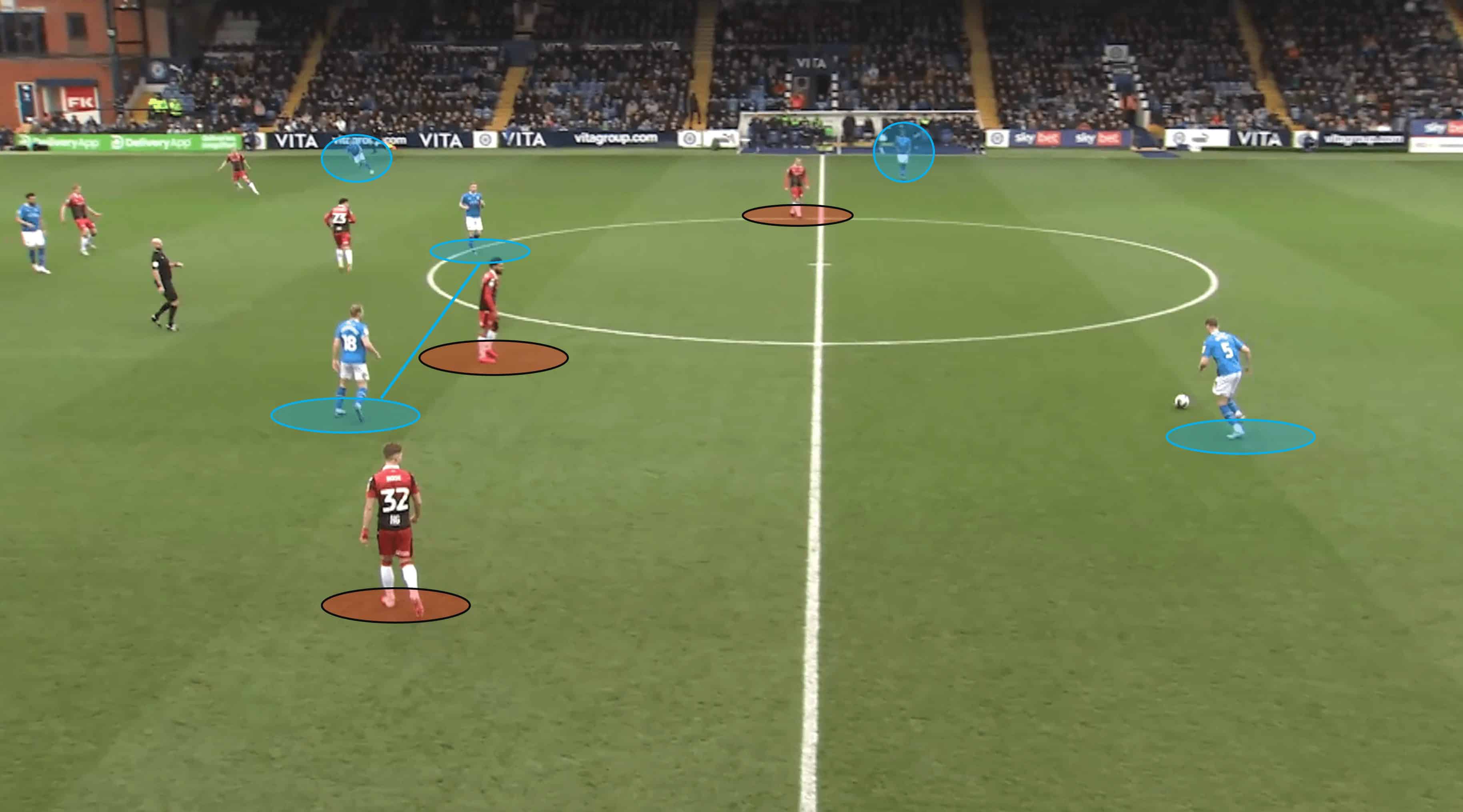
As mentioned, Stevenage did a lot of defending in the first half, but most of said defending was done in situations like this (or slightly higher up the pitch from Stockport’s perspective) – setting a mid-block to try and stifle County’s chances of playing through the third, but their positioning also made it difficult to adopt tactics of a switch-play method.
Looking at Stockport’s shape and positioning, we would often see the three CBs split, with the two outside CBs practically operating as full-backs in possession. Not only did this give their side more width to try and stretch their opponents, but it also gave the wing-backs the licence to push forward into attacking areas. The two deeper central midfielders would often be situated as they are above, offering little support to the man on the ball, as County weren’t interested in playing through the centre. Instead, the midfielders’ role was to be prepared in case of a turnover in play.
The man who was given the role of ball-playing CB was Neill Byrne, who was the most central of the three. He showed a desire to hit those long flat/driven passes into the channel but rarely did it work due to the quality of the pass but also the defensive positioning. Byrne was instrumental in getting the ball rolling in possession, and as his pass map below shows us, he was heavily involved.
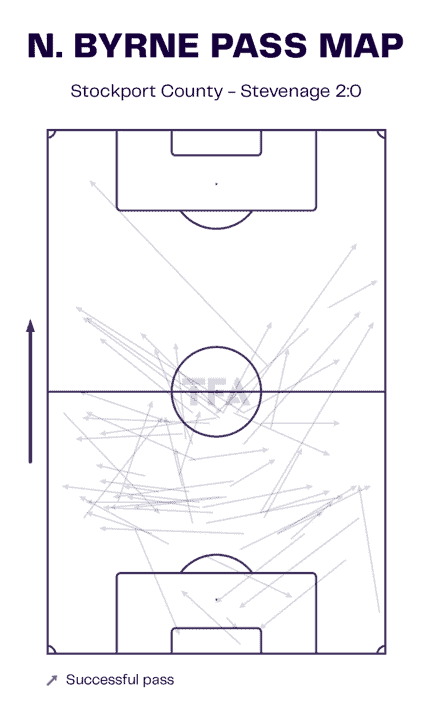
Compared with the other central defenders (from both sides), Byrne has a considerable amount of successful passes to his name for this fixture. Notice some of the patterns that occur – a fair number of lateral passes; these would have been out to his wide CB a lot of the time. Then, we can see when he passes from the centre circle, he is often looking to find what would likely be the wing-back on either side – his passes out to the left flank seem to have a more consistent placement in comparison to the right flank. It is also worth noting that of all the successful passes on that map above, there are very few long passes, as we touched upon before.
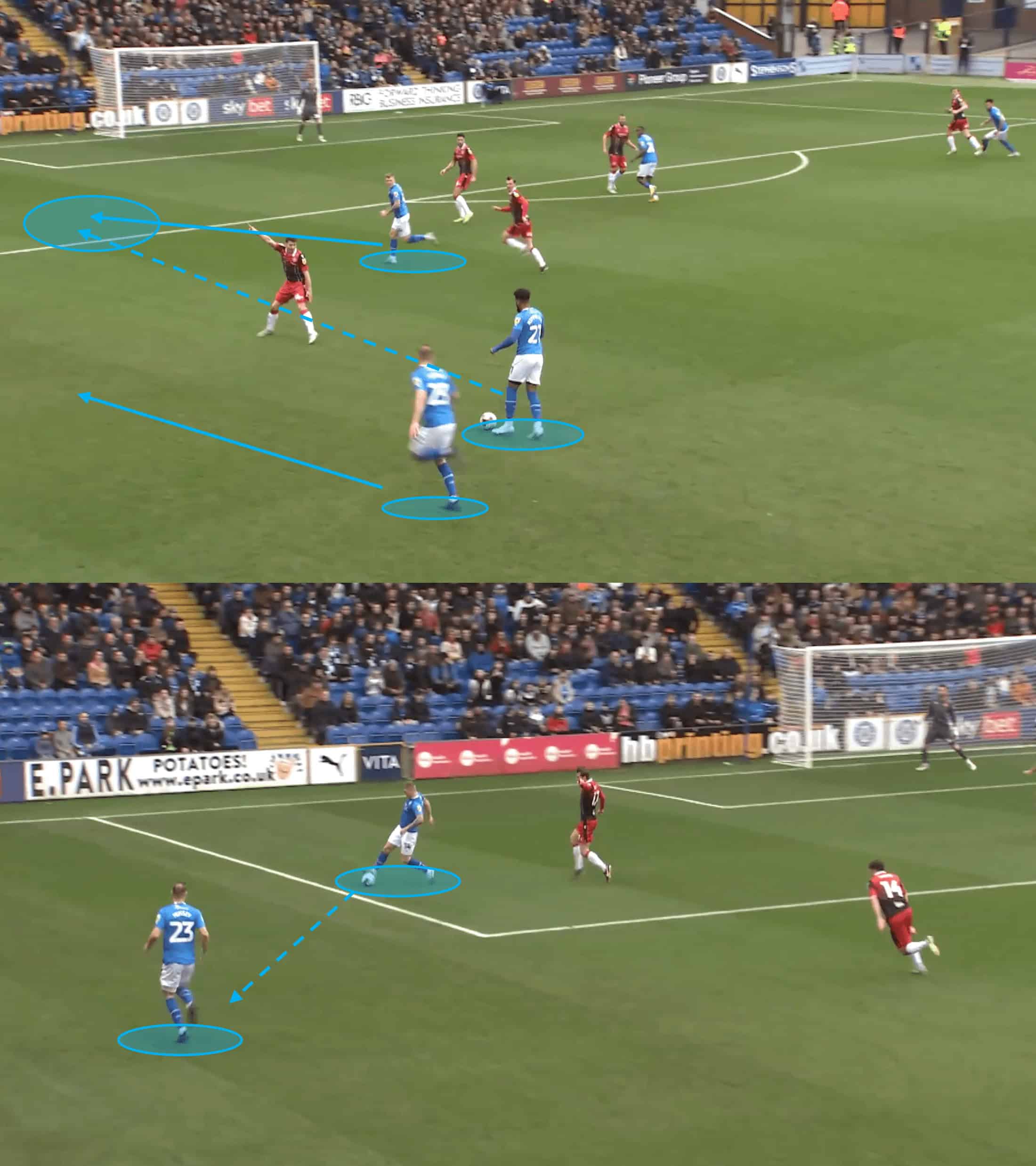
Playing in the channels was also an important element of Stockport’s tactics as they looked to exploit gaps between Stevenage defenders. In the image above, left wing-back/midfielder Myles Hippolyte is seen driving forward with two very good passing options in his sight. He opts for the pass into the channel for the run made by his teammate in attack, despite LCB Chris Hussey offering a strong supporting position in a wider area. It made for a good attacking move, though, as the forward who collected Hippolyte’s through pass bounced it straight back to Hussey – just like that, with a couple of simple yet very effective passes, Stockport turned regular possession into dangerous possession in the final third.
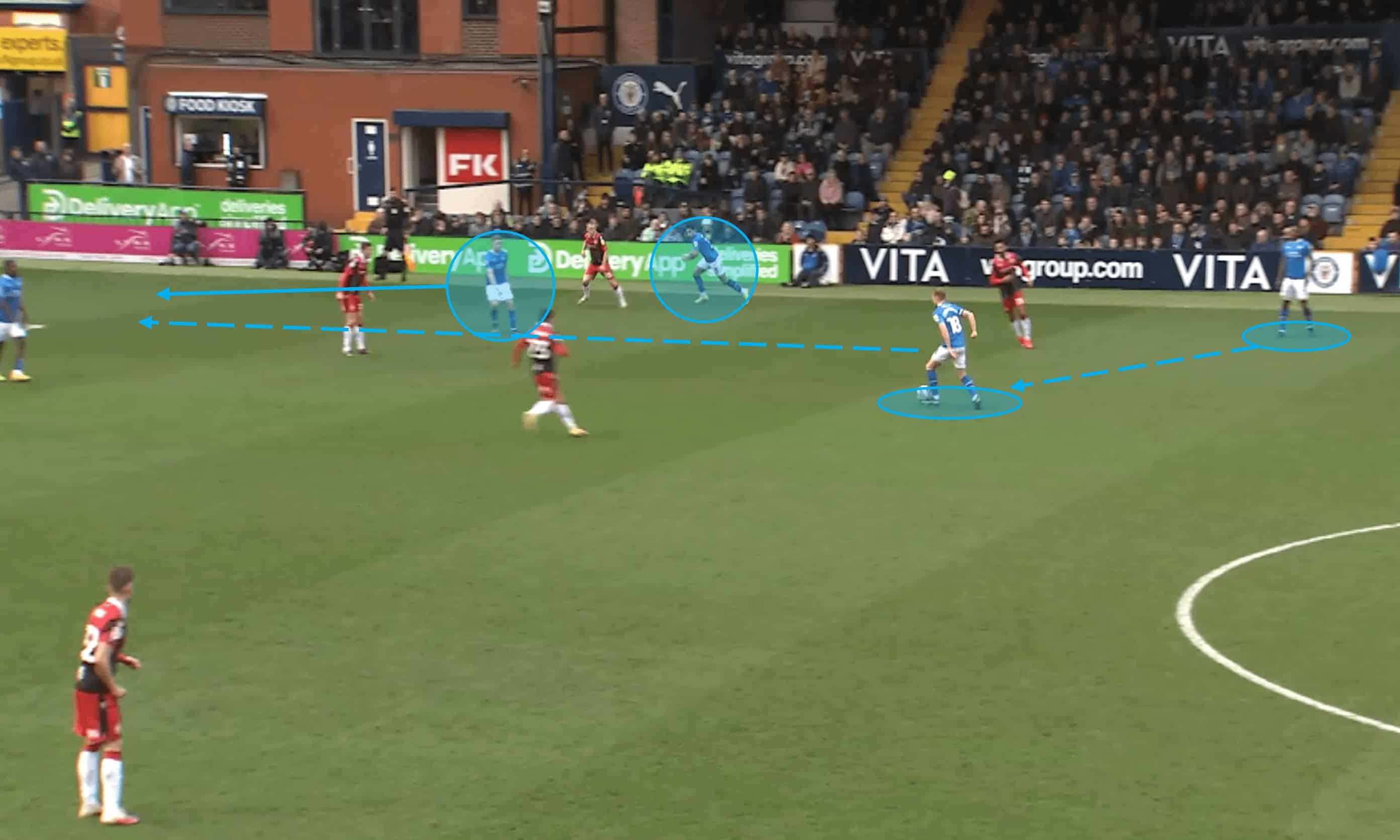
Dominating the ball the way Stockport did in the first half saw them grow in confidence as the half went on, while they also figured out that they can hold the comfortable possession from midfield rather than the halfway line, effectively piling more pressure onto Stevenage.
As you can see above, they were fond of playing through the flanks, as we will analyse in more detail soon – you can see this in the image above by the two players high up on the right flank – lacklustre defending from their counterparts helped them turn this piece of possession into a dangerous chance. Ryan Croasdale has the ball for his side in midfield after receiving it from Akil Wright (the high and wide CB coming into play again), and he immediately wants to penetrate Stevenage’s defence with a pass. He wastes no time doing so, picking out a ball with excellent quality into the channel for his teammate to run onto. That teammate collected the ball, drove towards the box and delivered a fierce delivery across the box – he was unlucky that a teammate wasn’t on the end of it.
County target wide areas in build-up play
It would be inaccurate to say that everything came through the flanks from County, but most of their dangerous work originated from these areas. However, instead of the system of “knock the ball wide and let the winger put some crosses in”, they instead utilised the wings to form the foundations of build-up play phases. However, when the chance came, they did occasionally look to get into strong crossing positions.
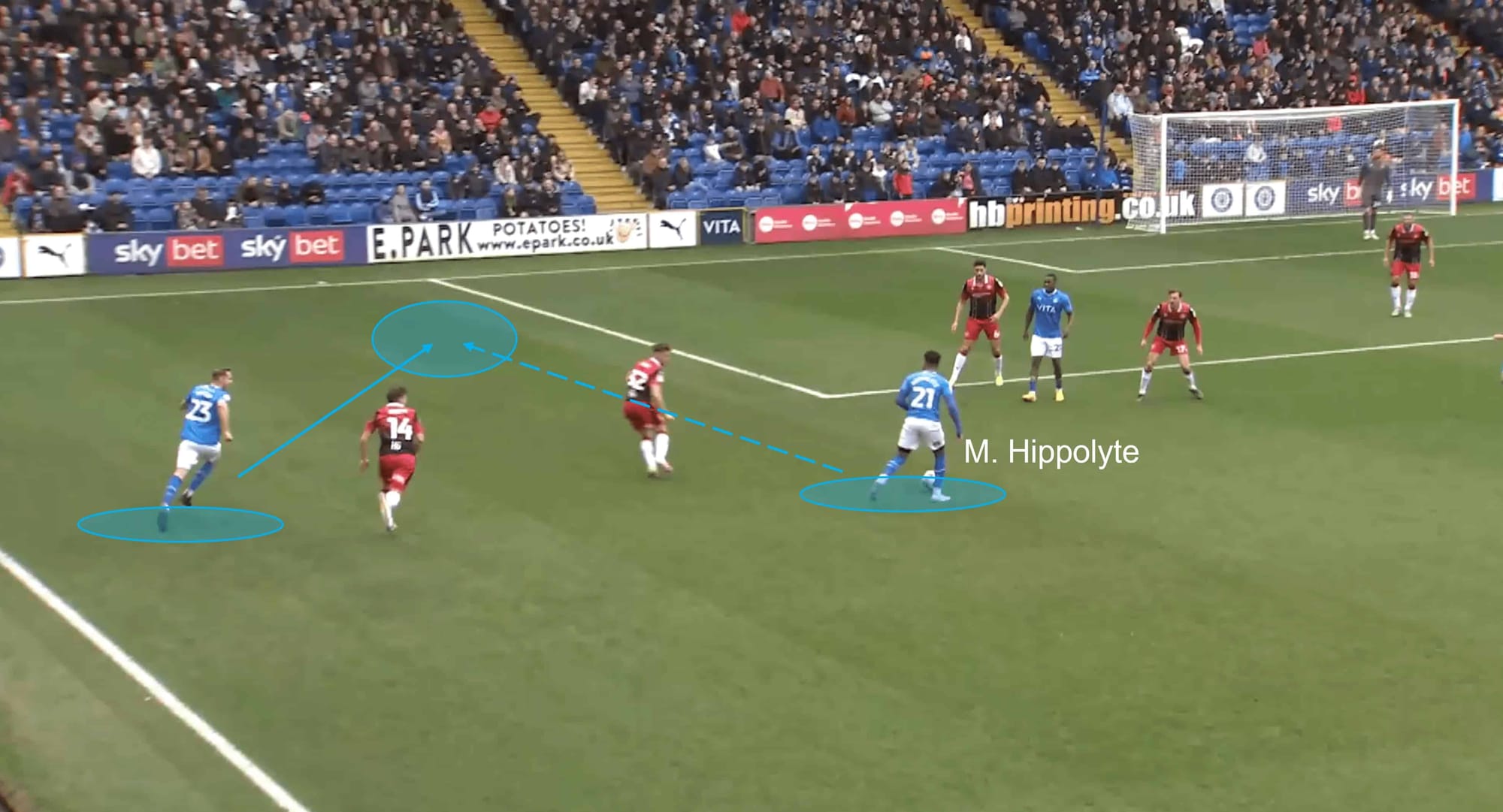
Hippolyte is in possession above, having just received the ball from Hussey via a throw-in. He initially takes the ball inside, but shows brilliant awareness and understanding of his teammate, as well as vision, to pick out an inch-perfect pass for Hussey to collect.
The CB-turned-winger in this move took the ball toward the byline and delivered an inviting cross, but Stevenage were able to defend it. While this may be a simple move from County at face value, the individual movement and timing of the pass was spot-on and allowed this move to become a dangerous piece of attacking play.
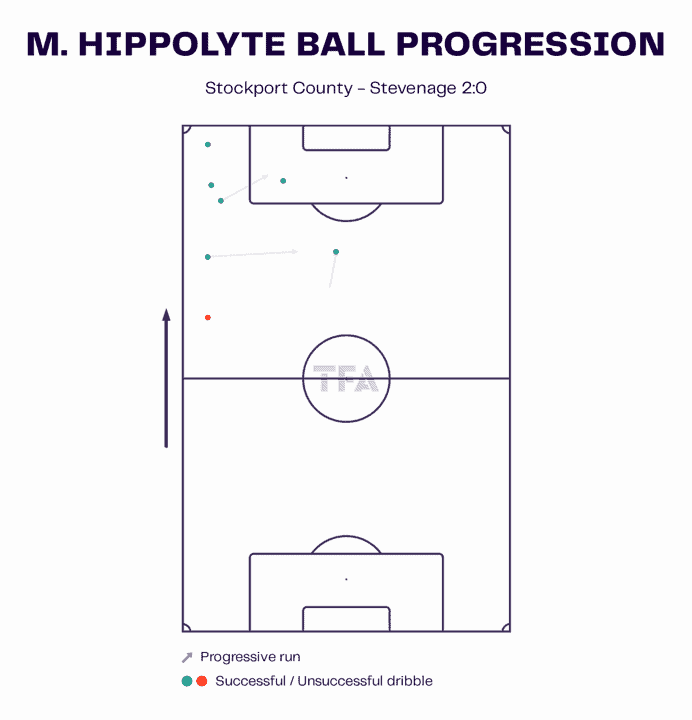
Hippolyte was a real threat in this tie, and the winger played both the attacking and defensive sides of his role nicely. Not only did he bag the assist for his team’s first goal, but he made life hell for Stevenage’s defensive unit, making four successful dribbles from the left flank, and two from the centre – just an insight into how Stevenage struggled to stop this man most of the time.
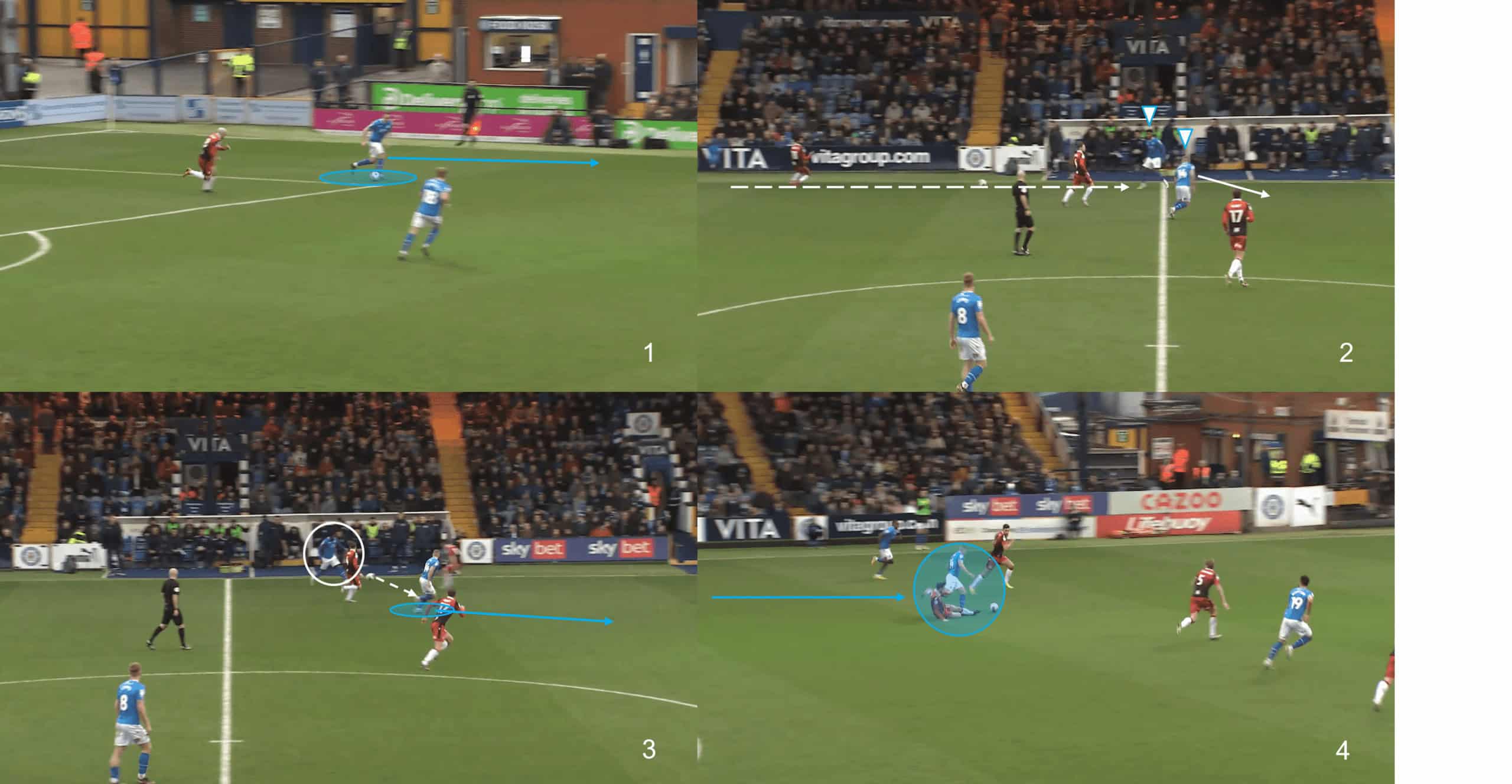
This four-piece image breaks down an excellent Stockport move, and it harks back to what we mentioned earlier: using wide areas as bases for build-up play. Hussey begins the move with the ball, and drives up into a higher, wider position, before firing a pass down the line to Hippolyte. He shows good awareness again, this time to knock the ball past an oncoming opponent into the path of nearby Will Collar, who showed very good positioning and movement to support Hippolyte. Collar drove forward, looking to burst into the final third, before being hacked down, winning a free kick for his team. This a very nice example of an effective passing sequence with utilised wide areas.
Why Stevenage’s second-half fight wasn’t enough
Stevenage did well to stay in the game up until halftime, and it was somewhat inevitable that they would begin to have their say on proceedings. Stockport still won the battle for possession in the second period, but it was closer than the first half, with automatic promotion chasers Stevenage giving County’s defence a couple of wake-up calls. In the end, despite their raised efforts, the quality lacked in some areas, as discussed below.
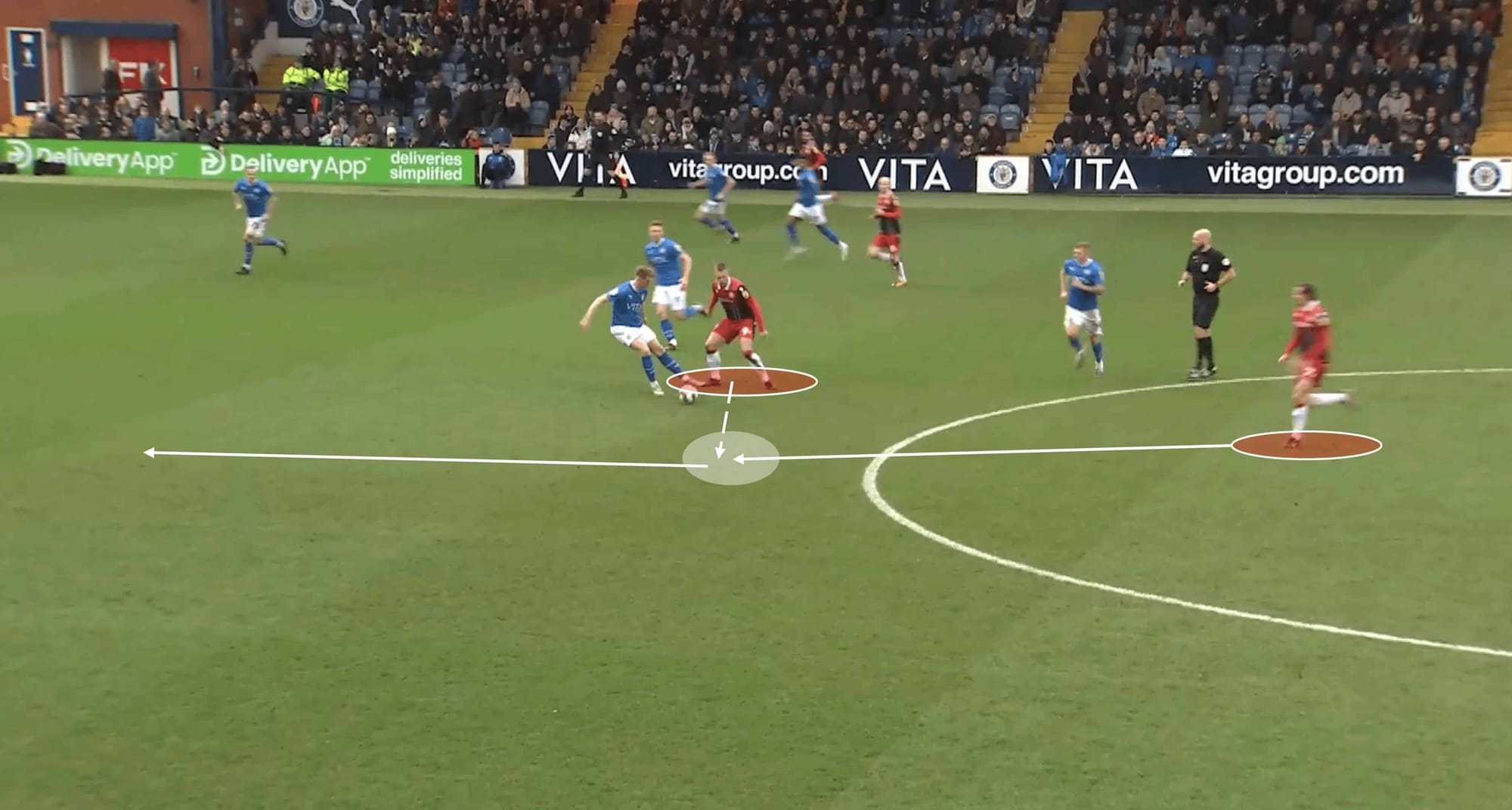
Getting the strikers into the game was a huge difficulty for Steve Evans’ side in the first 45 minutes, but they were able to be more involved after the break. Above, we see Luke Norris dropping deep to act as a makeshift target man amid an attacking transition for his team. Norris shows good physical attributes to hold the defender off, before laying a pass off to supporting midfield teammate Alex Gilby, who was arguably Stevenage’s brightest creative spark on the day.
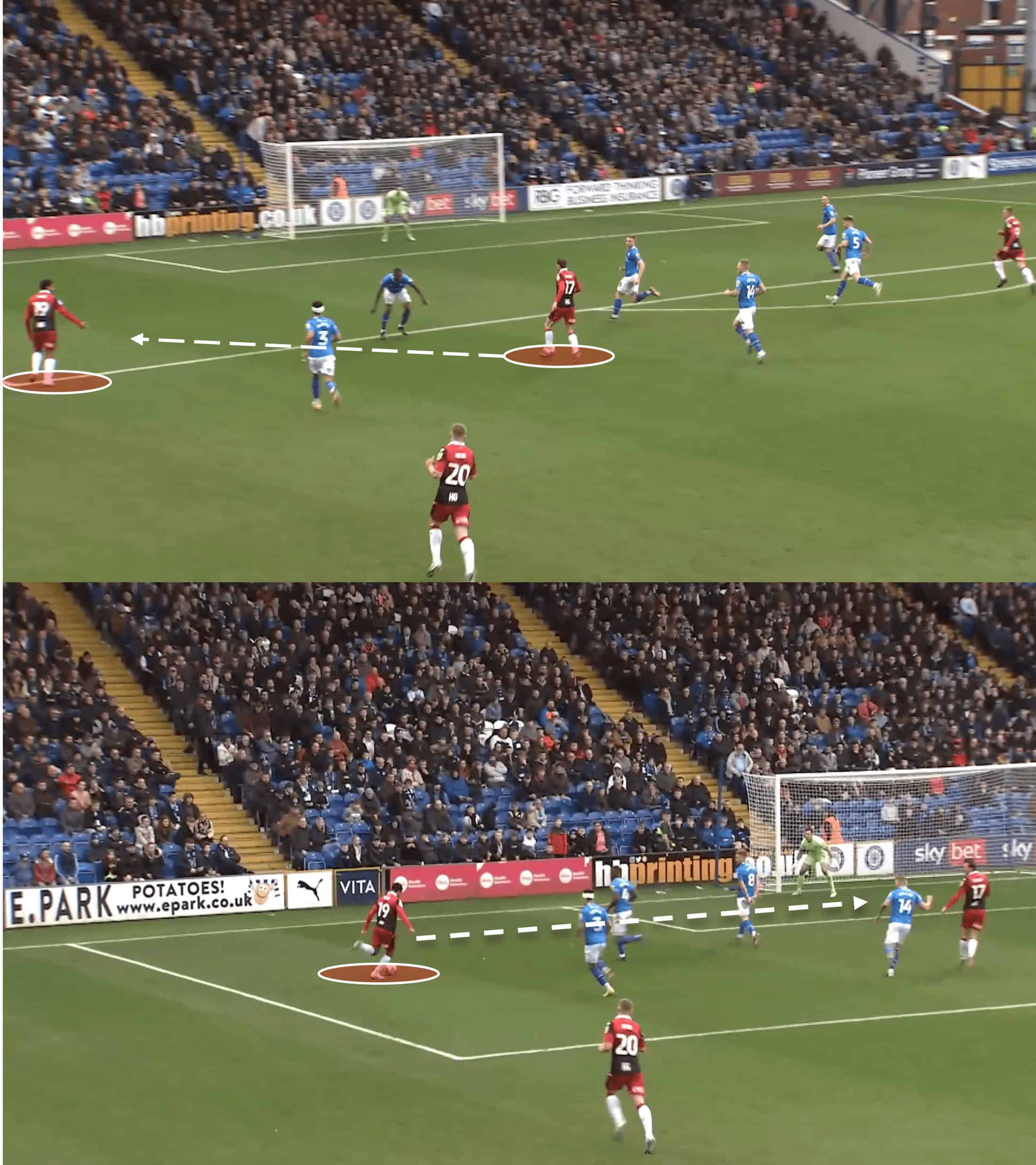
Gilbey showed the attacking intent that needed to be injected in Stevenage, taking the ball up to the edge of the box before placing a well-timed pass into substitute Jamie Reid, who delivered a dangerous ball across the face of goal – no goal for Stevenage from what was one of their best, if not the best passages of play in the game.
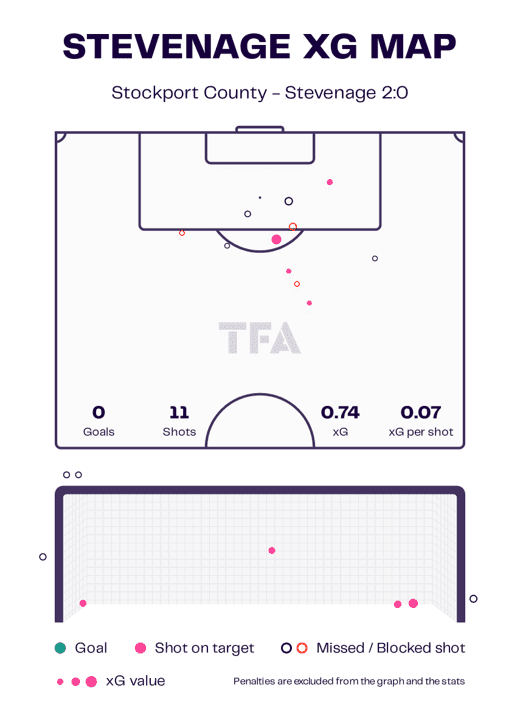
Stevenage’s xG gives us some insight into why they struggled so much when it came to threatening Stockport. Sure, 11 shots with four on target doesn’t seem terrible, but looking closer at those shots gives us a huge indication of their failure. They managed just one shot on target outside of the box, while seven of the 11 efforts on goal came from outside the area, highlighting a real struggle to break Stockport down; or find the right pass at the end of a passage of play.
Conclusion
This was the perfect time for Stockport to face a promotion rival, given their win-streak which now stands at four, while it was probably the worst time for Stevenage to play this game as they are now without a league win since hammering league leaders Leyton Orient 3-0 back in January.
It was not a terrible performance from Evans’ side, they just did not show enough mettle across the 90 minutes against a Stockport side who had some quality moments and took their chances to score – the second goal at the death coming as a result of a horrible error from the Stevenage goalkeeper. Evans won’t be too worried, however, as their promotion bid still stands strong, but they will be desperate to return to winning ways.
Stockport will be buzzing with their form and will look to continue it as we enter the final 13 or so games of the regular season.

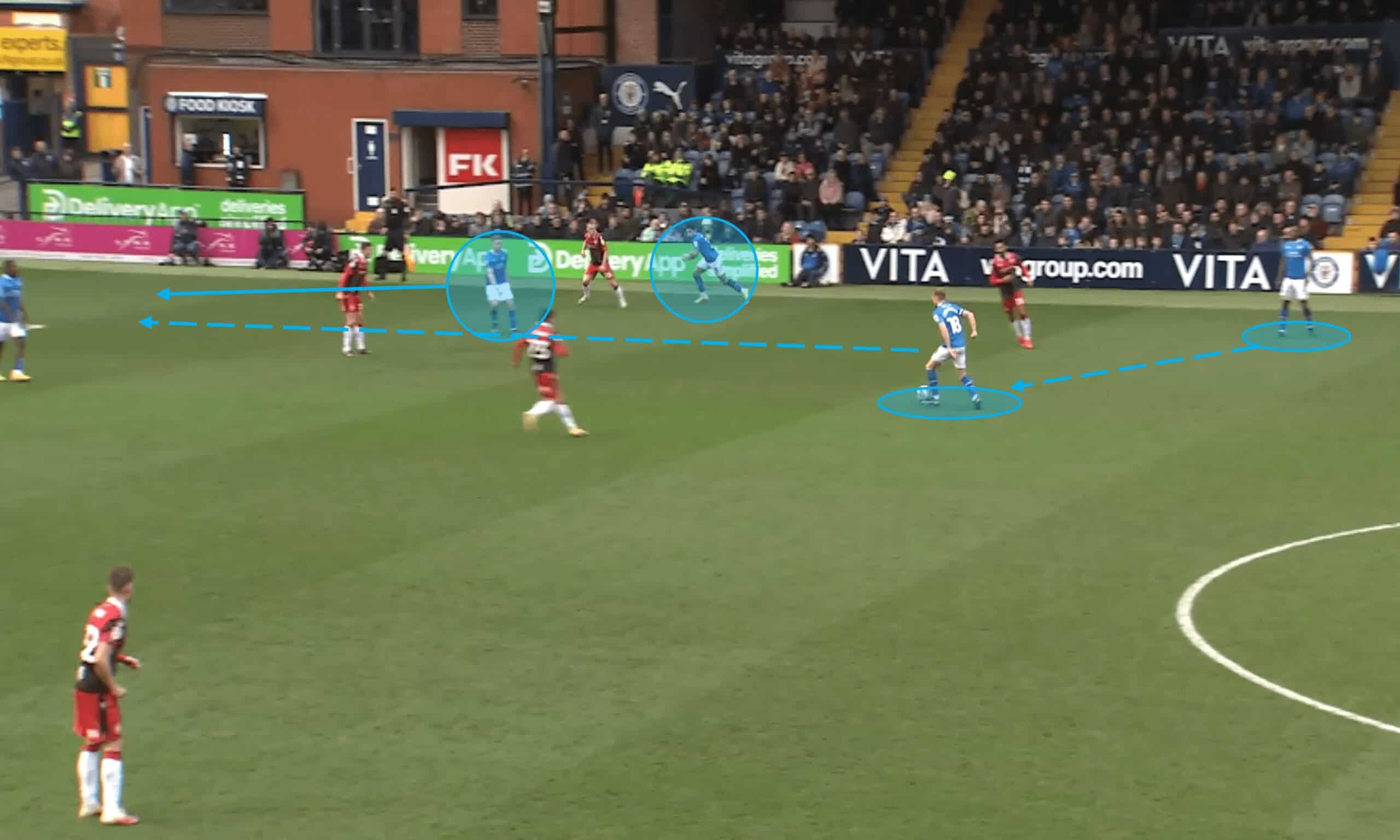




Comments